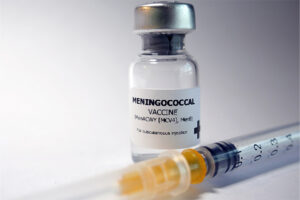Infectious Diseases
Adolescent Vaccinations
Meningococcal Disease: Special Populations and Persons at Increased Risk
Individuals of any age can contract meningococcal disease, but incidence rates are highest during infancy, with a second peak occurring during adolescence. Aside from age, risk factors are numerous and include environmental risks (eg, living in close quarters), host-related risks (eg, complement deficiency), and pathogen-related risks (eg, virulence factors).
There are many studies that have looked at risk factors for contracting invasive meningococcal disease. At the general population level, the most important risk factor is age: specifically, being under 1 year of age and then being a teenager or young adult. As a result, the Centers for Disease Control and Prevention recommends that adolescents should receive the meningococcal conjugate (MenACWY) vaccine beginning at age 11 or 12 years, with a booster dose at age 16 years, and may receive the serogroup B meningococcal (MenB) vaccine between ages 16 and 23 years, with the preferred age being 16 to 18 years. Also, as people get much older, they experience immune senescence and may be at a higher risk for developing infections.
After age, a person’s living situation is an important factor to consider because it is clear that meningococcal bacteria are transmitted from person to person, probably through the exchange of secretions. The vaccine is universally given to military recruits because they live in close quarters. Certainly, living in a community where there is a high incidence of disease is a risk, and we have numerous examples of outbreaks, including on college campuses.
There are social situations to consider that may increase the risk of disease transmission. A crowded bar where everybody is talking, smoking, and drinking is an example of a worst-case scenario because you may have people there who are colonized with a meningococcal strain, and there are large droplets in the air. If the mucosal membranes are already irritated, the bacteria can more easily colonize in the throat and then gain access to the bloodstream. That is also why wintertime is a risk factor. People are inside, often in close quarters, and heaters might dry out the air, which can dry out the mucosal membranes and allow for easier colonization if exposed.
It is important to note that if an outbreak does occur, special vaccination guidelines will be determined by local public health authorities. As providers, we would be notified by the local public health authorities when vaccines should be more broadly administered in a community. In this circumstance, that decision does not need to be made at the individual provider.
There are organism-specific factors to consider that may confer an increased risk as well. Some meningococci have increased virulence and are better able to colonize and invade. There may be an increased presence of cocirculating respiratory viruses, which, again, can disrupt that epithelial barrier and more easily allow for the development of invasive disease.
Specific chronic diseases or immunologic factors can also increase the risk of meningococcal disease. Children with HIV, for example, should be started on the MenACWY vaccine series and get boosters every 5 years. At the age of 10 years, they should start the MenB vaccine series and get boosters after that. Asplenia is a risk factor because the spleen is where opsonized bacteria are extracted from circulation and killed. Without a spleen, that may not happen. Anatomic and functional asplenia confer an increased risk. Children with sickle cell disease may be functionally asplenic at a young age, mostly due to repeated infarcts. These children should be immunized with the MenACWY vaccine series and should receive MenB when age eligible.
Complement deficiency is also a risk factor. You need complement to induce an inflammatory response and effectively fight infections, but those with a complement deficiency are not able to do that. Unfortunately, we typically will not know if a child has a complement deficiency until they are older. It is only after years of a patient coming in with recurrent pneumonia or sinusitis that we begin to wonder if there could be a problem immunologically. Indeed, it may even be the child presenting with meningococcal disease that leads to the diagnosis of complement deficiency. The risk of invasive meningococcal disease also increases substantially in persons receiving complement inhibitors such as eculizumab and ravulizumab.
There are other high-risk groups, such as people who travel to countries where meningococcal disease may be more prevalent. There are epidemiological risk groups, such as people working in a microbiology lab who might be exposed to the organism. Pregnancy, per se, is not a risk factor for invasive meningococcal disease. However, when meningococcal vaccination is otherwise indicated, as in the case of an expectant mother with complement deficiency or asplenia, meningococcal vaccines should be given.
Centers for Disease Control and Prevention. Meningococcal. CDC Website. Updated October 12, 2021. Accessed March 19, 2023. https://www.cdc.gov/vaccines/vpd/mening/index.html
Herrera-Restrepo O, Clements DE, Conley WJ, Marshall GS. Expert perspectives on the vaccination of individuals who are at increased risk of meningococcal disease due to medical conditions: a podcast. Infect Dis Ther. 2023;12(4):1019-1027. doi:10.1007/s40121-023-00778-1
Lundbo LF, Benfield T. Risk factors for community-acquired bacterial meningitis. Infect Dis. (Lond). 2017;49(6):433-444. doi:10.1080/23744235.2017.1285046
Marshall GS. The Vaccine Handbook: A Practical Guide for Clinicians. 8th ed. Professional Communications, Inc.; 2018.
Pardo de Santayana C, Tin Tin Htar M, Findlow J, Balmer P. Epidemiology of invasive meningococcal disease worldwide from 2010-2019: a literature review. Epidemiol Infect. 2023;151:e57. doi:10.1017/S0950268823000328











